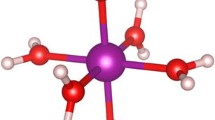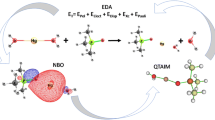Abstract
The trend in the first ligand dissociation energies of the subcarbonyl and carbonyl complexes Ni(CO) m , m = 1–4, is a typical example for consequences of the self-interaction error in calculations using semi-local density functional approximations. The self-interaction effects on bond lengths and ligand dissociation energies are examined with the DFT + Umol approach, an extension of the DFT + U method to molecular orbitals. A detailed analysis shows that (1) the Ni 3d subshell is most affected by self-interaction and (2) the +Umol correction on the CO 2π* orbitals has no major positive effect on the nickel carbonyl complexes, at variance with similar models for the CO adsorption on surfaces of transition metals.


Similar content being viewed by others
References
Dyson PJ, McIndoe JS (2000) Transition metal carbonyl cluster chemistry, vol 2. Advanced chemistry texts. OPA, Amsterdam
Elschenbroich C (2006) Organometallics. Wiley VCH, Weinheim
Macchia P, Sironi A (2003) Coord Chem Rev 238–239:383–412
Mond L, Langer C, Quincke F (1890) J Chem Soc Trans 57:749–753
Blomberg M, Brandemark U, Siegbahn P, Wennerberg J, Bauschlicher CW Jr (1988) J Am Chem Soc 110:6650–6655
Blomberg M, Siegbahn P, Lee TJ, Rendell AP, Rice JE (1991) J Chem Phys 95:5898–5905
Xu X, Lü X, Wang N, Zhang Q, Ehara M, Nakatsuji H (1999) Int J Quantum Chem 72:221–231
Chang C-R, Zhao Z-J, Köhler K, Genest A, Rösch N (2012) Catal Sci Tech 2:2238–2248
Stammreich H, Kawai K, Sala O, Krumholz P (1961) J Chem Phys 35:2168–2174
DeKock RL (1971) Inorg Chem 10:1205–1211
Hedberg L, Ijima T, Hedberg K (1979) J Chem Phys 70:3224–3229
Stevens AE, Feigerle CS, Lineberger WC (1982) J Am Chem Soc 104:5026–5031
Sunderlin LS, Wang D, Squires RR (1992) J Am Chem Soc 114:2788–2796
Manceron L, Alikhani ME (1999) Chem Phys 244:215–226
Liang B, Zhou M, Andrews L (2000) J Phys Chem A 104:3905–3914
Jansen HB, Ros P (1969) Chem Phys Lett 3:140–143
Jörg H, Rösch N (1985) Chem Phys Lett 120:359–362
Rösch N, Jörg H, Kotzian M (1987) J Chem Phys 86:4038–4045
Chung S-C, Krüger S, Pacchioni G, Rösch N (1995) J Chem Phys 102:3695–3702
Matveev A, Staufer M, Mayer M, Rösch N (1999) Int J Quantum Chem 75:863–873
Wolters LP, Bickelhaupt FM (2013) ChemistryOpen 2:106–114
Cohen AJ, Mori-Sánchez P, Yang W (2012) Chem Rev 112:289–320
Janak JF (1978) Phys Rev B 18:7165–7168
Perdew JP, Parr GR, Levy M, Balduz JLJ (1982) Phys Rev Lett 49:1691–1694
Tsuneda T, Hirao K (2014) J Chem Phys 140:18A513
Anisimov VI, Zaanen J, Andersen OK (1991) Phys Rev B 44:943–953
Czyżyk MT, Sawatzky GA (1994) Phys Rev B 49:14211–14228
Dudarev SL, Botton GA, Savrasov SY, Humphreys CJ, Sutton AP (1998) Phys Rev B 57:1505–1509
Picket WE, Erwin SC, Ethridge EC (1998) Phys Rev B 58:1201–1209
Han MJ, Ozaki T, Yu J (2006) Phys Rev B 73:045110–045111
Kulik HJ, Cococcioni M, Scherlis DA, Marzari N (2006) Phys Rev Lett 97:103001–103004
O’Regan DD, Payne MC, Mostofi AA (2011) Phys Rev B 83:245124
Cococcioni M, de Gironcoli S (2005) Phys Rev B 71:035105–035116
Kresse G, Gil A, Sautet P (2003) Phys Rev B 68:073401–073404
Rohrbach A, Hafner J, Kresse G (2004) Phys Rev B 69:075413
Ramakrishnan R, Matveev A, Rösch N (2009) Chem Phys Lett 468:158–161
Ramakrishnan R, Matveev AV, Rösch N (2011) Comput Theor Chem 963:337–343
Ramakrishnan R, Matveev AV, Krüger S, Rösch N (2011) Theor Chem Acc 130:361–369
Ramakrishnan R (2011) The DFT + U method in the framework of the parallel density functional code ParaGauss. Doctoral dissertation, Technische Universität München, München
Soini TM, Krüger S, Rösch N (2014) J Chem Phys 140:174709
Blyholder G (1964) J Phys Chem 68:2772–2777
Belling T, Grauschopf T, Krüger S, Nörtemann F, Staufer M, Mayer M, Nasluzov VA, Birkenheuer U, Hu A, Matveev AV, Shor AV, Fuchs-Rohr MSK, Neyman KM, Ganyushin DI, Kerdcharoen T, Woiterski A, Majumder S, Gordienko AB, Huix i Rotllant M, Ramakrishnan R, Dixit G, Nikodem A, Soini TM, Roderus M, Rösch N (2012) ParaGauss, Version 4.0, Technische Universität München
Dunlap BI, Rösch N, Trickey SB (2010) Mol Phys 108:3167–3180
Perdew JP, Burke K, Ernzerhof M (1996). Phys Rev Lett 77:3865–3868
Adamo C, Barone V (1999) J Chem Phys 110:6158–6170
Weigend F, Ahlrichs R (2005) Phys Chem Chem Phys 7:3297–3305
Boys SF, Bernardi F (1970) Mol Phys 19:553–566
Eichkorn K, Treutler O, Öhm H, Häser M, Ahlrichs R (1995) Chem Phys Lett 240:283–290
Eichkorn K, Weigend F, Treutler O, Ahlrichs R (1997) Theor Chem Acc 97:119–124
Becke AD (1988) J Chem Phys 88:2547–2553
Lebedev VI (1975) Zh vychisl Mat mat Fiz 15:48–54
Lebedev VI (1976) Zh vychisl Mat mat Fiz 16:293–306
Savin A (1996) On degeneracy, near-degeneracy and density functional theory. In: Seminario JM (ed) Recent Developments and Applications of Modern Density Functional Theory, vol 4., Theoretical and computational chemistry. Elsevier, Amsterdam, pp 327–357
Warren KD (1973) J Phys Chem 77:1681–1686
Pulay P (1980) Chem Phys Lett 73:393–398
Nikodem A (2013) ParaGauss and ParaTools—transition state search and efficient parallelization for density functional calculations. Doctoral dissertation, Technische Universität München, München
Fletcher R (1987) Practical methods of optimization, 2nd edn. Wiley, New York
Nikodem A, Matveev AV, Chaffey-Millar H, Soini TM, Rösch N (2012) ParaTools, Version 2.0, Technische Universität München
Anisimov VI, Solovyev IV, Korotin MA, Czyzyk MT, Sawatzky GA (1993) Phys Rev B 48:16929–16934
Huber KP, Herzberg G (1979) Constants of diatomic molecules. Van Nostrand-Reinhold, New York
Acknowledgments
We thank Dr. Sven Krüger and Dr. Alexander Genest for numerous discussions. TMS is grateful for support by the International Graduate School of Science and Engineering (IGSSE) of Technische Universität München.
Author information
Authors and Affiliations
Corresponding author
Rights and permissions
About this article
Cite this article
Soini, T.M., Rösch, N. A DFT + Umol model study of the self-interaction error in standard density functional calculations of Ni(CO) m (m = 1–4). Theor Chem Acc 133, 1561 (2014). https://doi.org/10.1007/s00214-014-1561-y
Received:
Accepted:
Published:
DOI: https://doi.org/10.1007/s00214-014-1561-y




